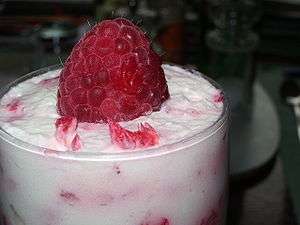Fruit fool
A fool is an English dessert. Traditionally, fruit fool is made by folding pureed stewed fruit (classically gooseberries) into sweet custard. Modern fool recipes often skip the traditional custard and use whipped cream. Additionally, a flavouring agent like rose water may be added.
 A raspberry fool | |
| Alternative names | Foole |
|---|---|
| Course | Dessert |
| Place of origin | England |
| Main ingredients | Puréed fruit, whipped cream, sugar |
| Variations | Trifle |
History and etymology
Foole is first mentioned as a dessert in 1598 (together with trifle),[1] although the origins of gooseberry fool may date back to the 15th century.[2] The earliest recipe for fruit fool dates to the mid 17th century.[3] Why the word "fool" is used as the name of this fruit dessert is not clear. Several authors derive it from the French verb fouler meaning "to crush" or "to press" (in the context of pressing grapes for wine),[4] but this derivation is dismissed by the Oxford English Dictionary as baseless and inconsistent with the early use of the word.[1]
Another possible, indeed plausible, origin of the word is that it is derived from the Arabic dish known as a ful, or foul (pronounced fool). A ful is a common Middle Eastern dish that has been around since Biblical times, most commonly made from cooked softened and mashed beans, flavoured with garlic or spices or even cream or laban. While the ingredients may be different, the concept and preparation of the Middle Eastern vegetable foul and the English fruit fool are remarkably similar, suggesting that this is the origin of the term.
Variations
Originally, the most common fruit ingredient in fools was gooseberries, although other fruits, vegetables and berries are known from early recipes, e.g., apples, strawberries, rhubarb and raspberries. Modern recipes may include any seasonal fruit readily found, but gooseberry fool[5] remains the perennial favorite.
Norfolk fool[6] is an old local variation of the fruit fool which seems to treat the fruit content more as a secondary ingredient, adding it at the end of the recipe.
See also
- Compote
- Crème brûlée
- Eton mess
- List of desserts
- List of fruit dishes
- Panna cotta
- Pavlova (food)
- Smoothie
References
- Oxford English Dictionary, second edition, 1989.
- Garmey, Jane. Great British Cooking: A Well Kept Secret. New York: Random House, 1981
- The compleat cook, anonymous (W.M.), 1658
- Hibler, Janie. The Berry Bible, Harper Collins Publishers, 2000, page 306
- Recipe for gooseberry fool Archived 2010-07-13 at the Wayback Machine (accessed 1 July 2010).
- The accomplisht cook, by Robert May, 1660-1685